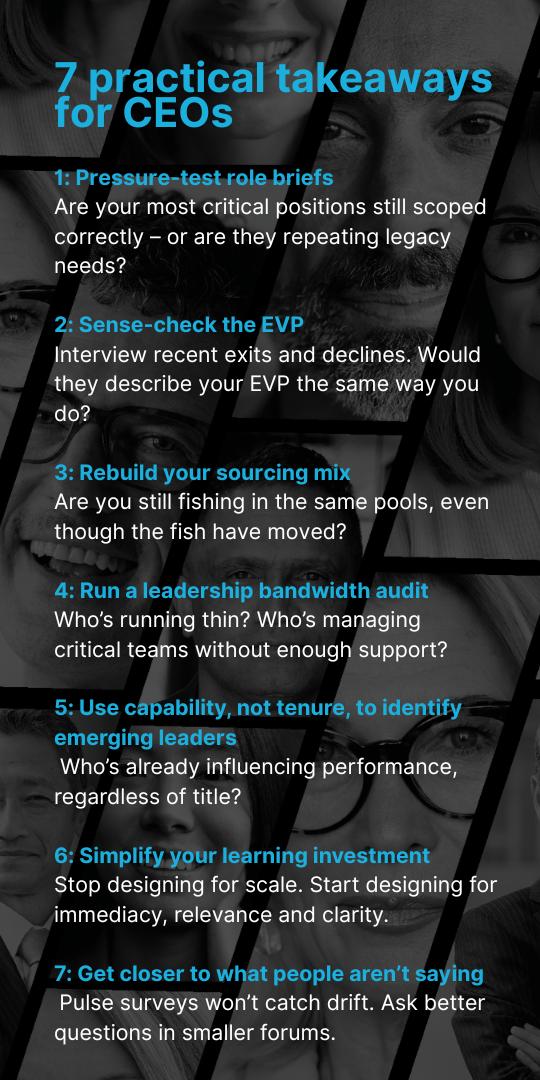Talent issues don’t always announce themselves. More often, they surface in low-friction exits, offer rejections or stalled hires. Or in something quieter, like a high performer stepping back, disengaging without ever saying the words.
Most CEOs aren’t ignoring people. But many are still making decisions off lagging indicators – not live ones. And when things do start to shift, the response often comes too late.
In 2025, staying close to your people is a commercial necessity. Not a cultural one.
Conditions may feel calmer, but the pressure hasn’t gone away
Inflation has eased. The RBA has already cut rates twice this year, and with several of the major banks pre-emptively lowering rates ahead of the July decision, further easing is expected. Business confidence has started to lift, cautiously.
It’s not quite optimistic, but it is encouraging.
Meanwhile, job vacancies are rising, yet many roles remain open for months. Unemployment is low at 4.1%, but placements are taking longer. Growth plans are being debated – alongside cost freezes.
There’s no crisis to react to. But there’s no clear runway either.
This is the right moment to challenge legacy assumptions about headcount, capability and workforce structure. Especially before you’re forced to adapt under pressure. If you're waiting for certainty, you’ll be reacting when you should be leading.
EVP isn’t failing – it’s drifting
Your Employee Value Proposition – the promise you make to your people and candidates – doesn’t always break loudly. More often, it loses relevance quietly.
Candidates drop off late in the process. High performers start exploring options. Your message still sounds good, but just no longer sticks.
Instead of reinforcing the campaign, ask whether the experience still holds up.
- Does your EVP still reflect what your workforce values now?
- Are your leaders reinforcing it, or unintentionally contradicting it?
- Is it helping you stand out – or blending into a market of similar-sounding offers?
Sometimes, what’s needed isn’t a reinvention. It’s a reset.
The market isn’t tight. It’s misaligned.
You’re not competing for all talent. You’re competing for the right match.
Job ads are rising in trades, logistics, and hospitality. ICT and support roles are easing back. Yet across all sectors, roles are staying open longer – and the wrong candidates keep showing up.
Rather than a pipeline issue, we have a clarity problem.
Take a harder look at:
- Whether your job briefs are describing the role – or describing history
- Where you’re searching and whether that’s where talent actually is now
- What your internal data is telling you about time-to-fill and quality-of-hire
Hiring friction often reflects a misdiagnosed problem, so it’s best to fix the brief before you fix the channel.

AI is changing capability faster than most teams can adapt
Not just tools. Expectations. Judgement. Problem-solving. Communication. Adaptability. The roles you signed off last year may no longer be what the business needs most.
Most teams aren’t resistant to AI. They’re under-supported. People want clarity about how their role is evolving, what good looks like, and how to stay valuable.
If you're seeing hesitation, it's most likely not from a lack of willingness, but a lack of signal.
This is a leadership challenge – not just a learning one.
Leadership strain is the invisible risk on most P&Ls
The biggest retention trigger right now isn’t pay or perks – it’s leadership inconsistency.
Managers are managing more than ever. But many are doing it without the clarity, support or bandwidth they need. And it shows.
You’ll often spot it in:
- High performers walking without a fight
- Delayed decisions, even when priorities are clear
- Friction creeping into team dynamics that were previously solid
Most employee experience issues don’t start with culture. They start with the manager.
If you’re not building in space for leaders to lead – and measuring how effectively they do it – you’re leaving performance to chance.
It. is. intense. What’s working today may not hold tomorrow.
But that doesn’t mean we need to rebuild everything. We just need to pay sharper attention to what’s changing under the surface and act on it with intent, not optimism.
The strongest CEOs aren’t waiting for formal feedback or another market report. They’re seeing the signals early. Asking different questions. And adjusting before the numbers force them to.
Because in the end, the best retention strategy is relevance – consistently delivered.

.png)


